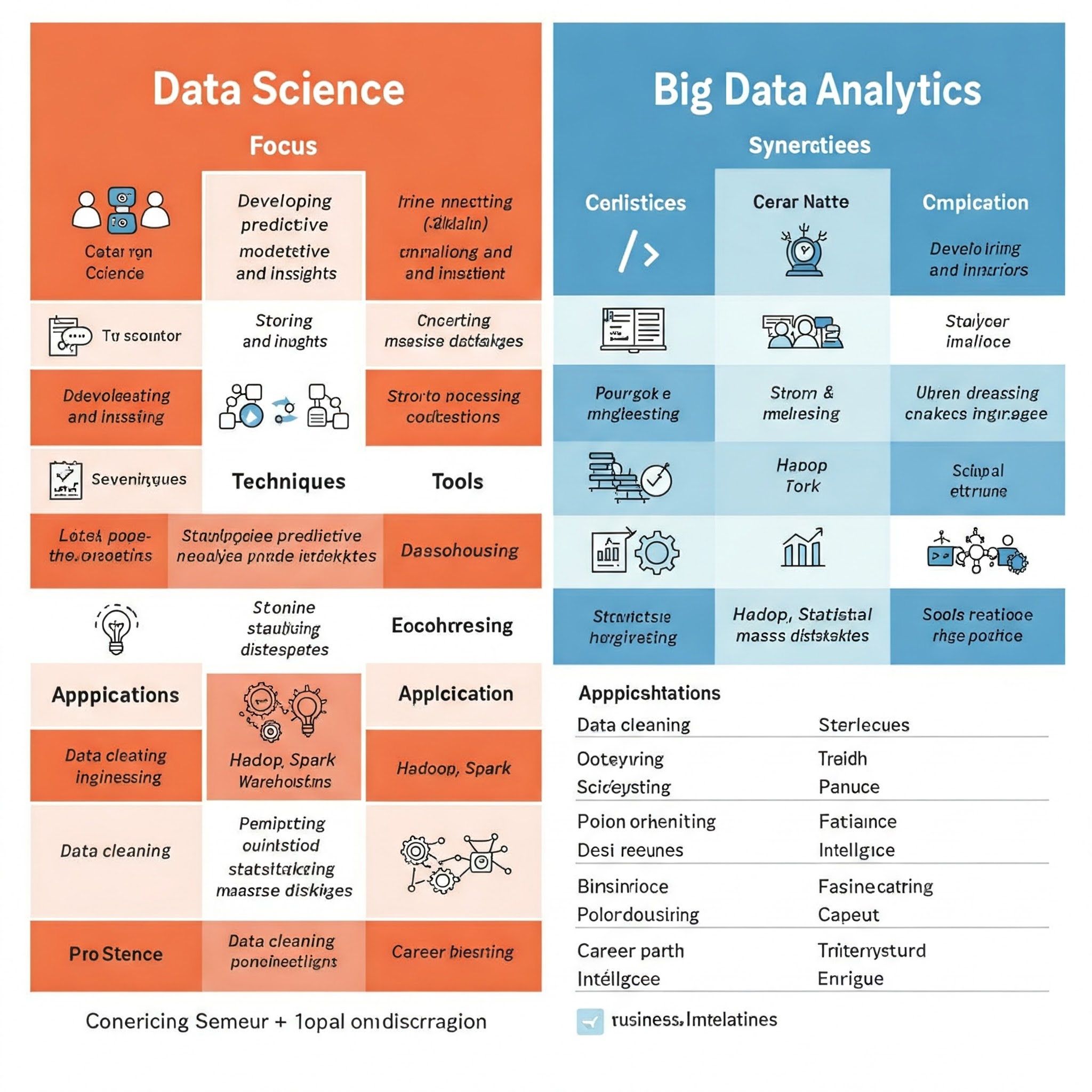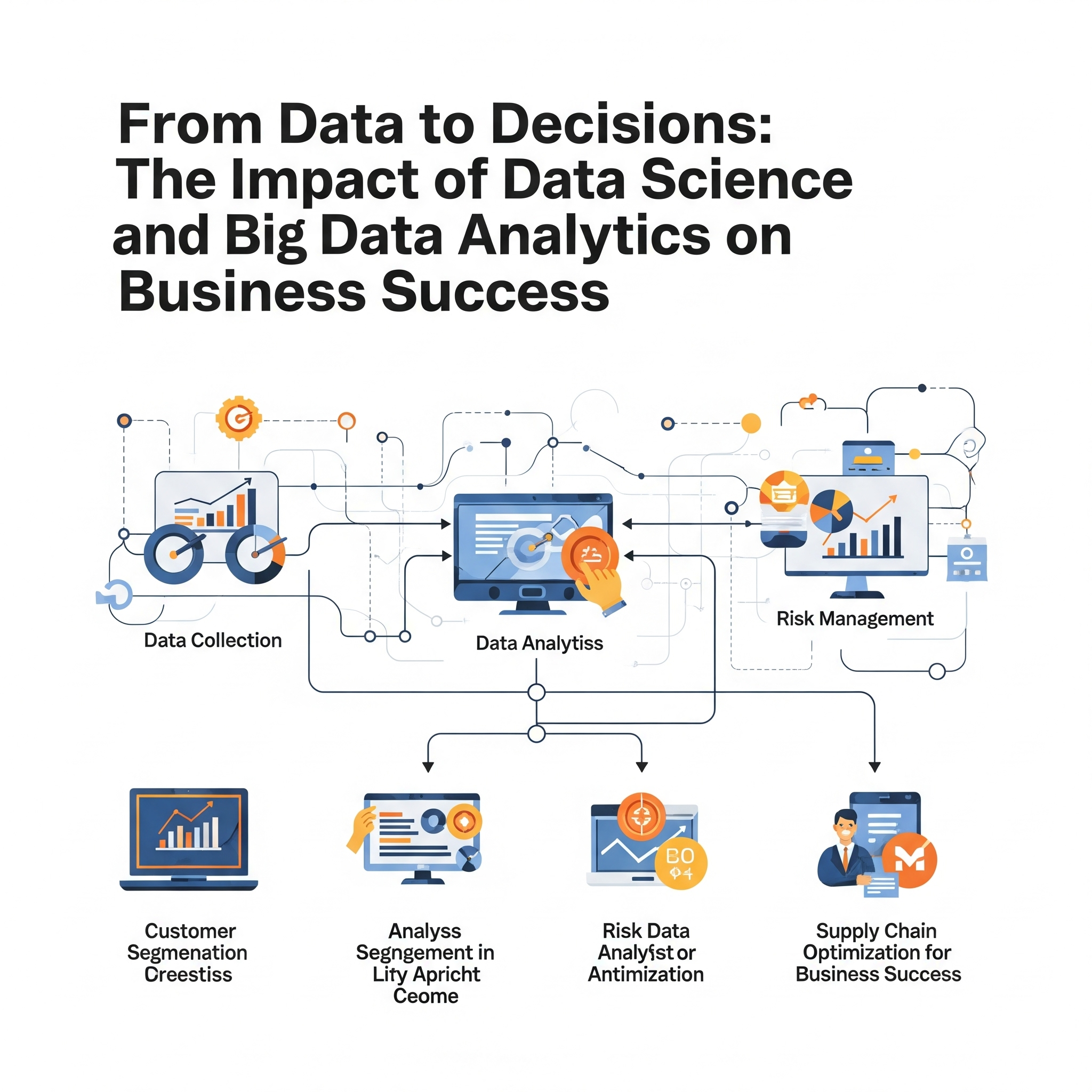In today’s data-driven business landscape, two terms frequently appear in discussions about extracting value from information: Data Science and Big Data Analytics. While often used interchangeably, these disciplines represent distinct approaches with different methodologies, objectives, and skill requirements. Understanding their differences and how they complement each other is crucial for organizations looking to build effective data strategies. This article explores the nuances that separate these fields while highlighting how their integration creates powerful capabilities for modern enterprises.
Defining the Disciplines
| Characteristic | Data Science | Big Data Analytics |
|---|---|---|
| Definition | An interdisciplinary field combining statistics, mathematics, computer science, and domain expertise to extract insights and knowledge from data | A discipline focused specifically on examining large volumes of data to uncover patterns, correlations, and insights |
| Key Focus #1 | Scientific methodology: Follows rigorous scientific approaches to problem-solving, forming hypotheses and testing them through experimentation | Volume-centric approaches: Explicitly addresses the challenges of processing massive datasets that exceed traditional database capabilities |
| Key Focus #2 | Prediction and prescription: Emphasizes predicting what will happen and prescribing actions to take | Specialized infrastructure: Employs distributed computing frameworks like Hadoop, Spark, and cloud-based data warehouses |
| Key Focus #3 | Algorithm development: Develops custom algorithms and statistical models for specific problems | Streaming and batch processing: Encompasses both real-time stream processing and batch processing methodologies |
| Key Focus #4 | Unstructured data handling: Effectively works with unstructured data like text, images, audio, and video | Business intelligence orientation: Has roots in business intelligence and reporting while evolving to include advanced techniques |
| Key Focus #5 | Machine learning implementation: Uses advanced machine learning techniques as core components | Structured and semi-structured data focus: Traditionally emphasizes structured and semi-structured data formats |
Core Differences Between Data Science and Big Data Analytics
1. Scope and Objectives
| Aspect | Data Science | Big Data Analytics |
|---|---|---|
| Scope | Broader discipline encompassing the entire data processing pipeline | More specifically focused on processing and analyzing large datasets |
| Primary Goal | Discovering new insights and creating predictive capabilities | Answering specific business questions with existing data |
| Approach | Generating actionable intelligence through advanced modeling | Extracting actionable insights from existing data |
| Problem Definition | Often explores open-ended questions without predefined answers | Typically addresses known business challenges with defined metrics |
| Solution Methods | Frequently addresses novel problems requiring custom approaches | Frequently implements established analytical frameworks |
2. Methodological Approaches
| Aspect | Data Science | Big Data Analytics |
|---|---|---|
| Core Methodology | Employs scientific method with hypothesis testing | Focuses on efficient processing of massive datasets |
| Modeling Approach | Includes advanced statistical modeling and machine learning | Employs established analytical techniques at scale |
| Research Orientation | Often implements experimental design | Emphasizes descriptive and diagnostic analytics |
| Innovation Level | Frequently creates new algorithms and approaches | Relies heavily on distributed computing frameworks |
| Analysis Focus | Places significant emphasis on causal inference and explanation | Prioritizes scalability and performance optimization |
3. Skill Requirements and Backgrounds
| Aspect | Data Science | Big Data Analytics |
|---|---|---|
| Core Knowledge | Requires deeper statistical and mathematical knowledge | Requires stronger data engineering and infrastructure knowledge |
| Technical Skills | Demands stronger programming capabilities (Python, R, etc.) | Demands familiarity with distributed computing frameworks |
| Specialized Expertise | Often requires machine learning expertise | Often requires SQL and data warehousing expertise |
| Background Advantage | Benefits from research experience and scientific background | Benefits from business intelligence background |
| Development Skills | Frequently involves algorithm development skills | Frequently involves data visualization and reporting skills |
4. Tools and Technologies
| Category | Data Science | Big Data Analytics |
|---|---|---|
| Primary Languages | Python, R, Julia | SQL, HiveQL, Scala |
| Key Libraries/Frameworks | TensorFlow, PyTorch, scikit-learn | Hadoop, Spark, Flink |
| Statistical Tools | SPSS, SAS, statsmodels | Data warehousing: Snowflake, BigQuery, Redshift |
| Development Environment | Notebook environments: Jupyter, RStudio | ETL tools: Informatica, Talend, Apache NiFi |
| Specialized Tools | Deep learning and NLP libraries | Visualization platforms: Tableau, Power BI, Qlik |
5. Typical Outputs and Deliverables
| Category | Data Science | Big Data Analytics |
|---|---|---|
| Primary Output #1 | Predictive models and algorithms | Dashboards and visualizations |
| Primary Output #2 | Machine learning pipelines | Business intelligence reports |
| Primary Output #3 | Complex statistical analyses | KPI tracking and monitoring |
| Primary Output #4 | Experimental results and interpretations | Operational analytics |
| Primary Output #5 | Research-oriented reports and publications | Data marts and warehousing solutions |
The Integration Continuum: Where They Meet
Despite their differences, data science and big data analytics exist on a continuum rather than as completely separate domains. In practice, effective organizations integrate both disciplines to create comprehensive data capabilities:
Data Engineering as the Foundation
Both disciplines rely on solid data engineering practices to succeed:
- Data collection and storage infrastructure
- Data cleaning and preparation pipelines
- Data governance and quality assurance
- Metadata management and documentation
- Security and compliance implementations
The Analytics Maturity Progression
Organizations typically evolve their data capabilities through stages that incorporate elements of both fields:
| Maturity Stage | Key Question | Characteristics | Primary Tools | Discipline Alignment |
|---|---|---|---|---|
| Descriptive Analytics | What happened? | • Historical reporting and dashboards<br>• Basic trend analysis<br>• Standard KPI monitoring | • Reporting tools<br>• Basic visualization<br>• SQL queries | Often the starting point for big data analytics implementations |
| Diagnostic Analytics | Why did it happen? | • Root cause analysis<br>• Correlation identification<br>• Anomaly detection | • Advanced visualization<br>• Statistical testing<br>• OLAP systems | Represents the intersection of traditional analytics and early data science |
| Predictive Analytics | What will happen? | • Forecasting models<br>• Risk assessment<br>• Customer behavior prediction | • Machine learning<br>• Statistical modeling<br>• Simulation tools | Combines big data infrastructure with data science methodologies |
| Prescriptive Analytics | What should we do? | • Optimization algorithms<br>• Decision support systems<br>• Recommendation engines | • Advanced algorithms<br>• ML operations<br>• AI systems | Represents advanced data science implemented at scale |
Real-World Integration Examples
Successful organizations integrate both disciplines to solve complex challenges:
Customer Experience Optimization:
- Big data analytics processes terabytes of customer interaction data
- Data science algorithms develop personalization models
- Infrastructure handles real-time implementation
- The combination delivers individually tailored experiences at scale
Supply Chain Optimization:
- Big data systems process global logistics and inventory data
- Data science creates demand forecasting models
- Together they enable dynamic inventory positioning
- The integration minimizes costs while maintaining availability
Fraud Detection:
- Big data infrastructure processes transaction streams in real-time
- Data science algorithms identify suspicious patterns
- The combination enables immediate intervention
- Continuous learning improves detection over time
Building Effective Teams Across the Spectrum
Organizations need talent spanning both disciplines to maximize value from data:
Specialized Roles
- Data Engineers: Build infrastructure and pipelines
- Data Analysts: Interpret data and create business intelligence
- Big Data Specialists: Implement scalable processing frameworks
- Data Scientists: Develop advanced models and algorithms
- ML Engineers: Deploy models into production environments
Collaboration Models
Effective teams structure collaboration across these roles:
- Hub and Spoke: Central data science team supporting business units
- Embedded Experts: Data specialists within business departments
- Center of Excellence: Shared resources and standardized practices
- Cross-functional Teams: Project-based groupings across disciplines
Skills Development Pathways
Organizations should create development paths that bridge disciplines:
- Data analysts expanding into predictive modeling
- Engineers gaining analytical and business knowledge
- Scientists learning infrastructure and scalability
- Domain experts acquiring data manipulation skills
Technological Convergence
The distinction between data science and big data analytics is blurring as technologies evolve:
Cloud-Based Integration
Cloud platforms now offer integrated environments that support both disciplines:
- Unified data lakes and warehouses
- Seamless scaling from small to massive datasets
- Integrated machine learning services
- End-to-end workflows from ingestion to deployment
Automated Machine Learning (AutoML)
AutoML platforms are democratizing advanced modeling capabilities:
- Automated feature engineering
- Model selection and hyperparameter tuning
- Deployment and monitoring integration
- Making data science techniques accessible to analysts
Unified Analytics Frameworks
Modern frameworks increasingly support both traditional analytics and advanced data science:
- Spark combines SQL analytics with machine learning
- Databricks integrates notebook-based exploration with production deployment
- Snowflake extends data warehousing to support ML workflows
- Streaming platforms incorporate complex event processing and ML inference
Industry-Specific Applications
Different sectors leverage the intersection of data science and big data analytics in unique ways:
| Industry | Application | Big Data Analytics Contribution | Data Science Contribution | Business Impact |
|---|---|---|---|---|
| Financial Services | Fraud Detection | Real-time processing of transaction streams | Anomaly detection algorithms and risk scoring models | Reduced fraud losses while minimizing false positives |
| Risk Management | Processing vast historical datasets | Comprehensive models incorporating thousands of variables | Better capital allocation and reduced default rates | |
| Algorithmic Trading | High-frequency market data processing | Statistical arbitrage and pattern recognition models | Improved trading performance and risk management | |
| Customer Intelligence | Integrating diverse customer data sources | Behavioral modeling and propensity scoring | Personalized services and improved retention | |
| Healthcare | Clinical Decision Support | Large-scale EHR system integration | Predictive models for patient outcomes | Improved clinical decision-making and reduced errors |
| Population Health | Processing demographic and epidemiological data | Risk stratification algorithms | Better resource allocation and preventive interventions | |
| Medical Imaging | Storing and processing large imaging datasets | Deep learning for diagnostic assistance | Earlier detection of conditions and reduced misdiagnosis | |
| Precision Medicine | Genomic data processing | Treatment response prediction models | Customized treatments with improved efficacy | |
| Retail | Demand Forecasting | Processing historical sales across channels | Time series and causal forecasting models | Reduced stockouts and inventory costs |
| Customer Segmentation | Integrating transaction and behavior data | Clustering and classification algorithms | Targeted marketing and improved conversion rates | |
| Price Optimization | Competitive and historical price analysis | Elasticity modeling and optimization algorithms | Maximized margins while maintaining competitiveness | |
| Supply Chain Analysis | Real-time inventory and logistics tracking | Network optimization algorithms | Reduced costs and improved service levels | |
| Manufacturing | Predictive Maintenance | Processing sensor data streams | Failure prediction models | Reduced downtime and maintenance costs |
| Quality Assurance | Real-time production data monitoring | Defect prediction algorithms | Improved product quality and reduced waste | |
| Supply Chain Optimization | Global logistics data integration | Multi-objective optimization models | Lower costs and increased resilience | |
| Product Development | Processing test and simulation data | Design optimization algorithms | Accelerated R&D and improved product performance |
Challenges at the Intersection
Organizations implementing integrated data strategies face several challenges:
| Challenge Category | Challenge | Description | Mitigation Approaches |
|---|---|---|---|
| Technical Challenges | Data Integration | Connecting disparate systems and formats | • Data virtualization<br>• API-based architectures<br>• Enterprise data catalogs |
| Scalability | Building solutions that grow with data volumes | • Cloud-native architectures<br>• Serverless computing<br>• Distributed processing | |
| Performance | Delivering insights at the speed of business | • In-memory processing<br>• Query optimization<br>• Data tiering strategies | |
| Technical Debt | Managing evolving architectures and legacy systems | • Modular design patterns<br>• Continuous refactoring<br>• Technical governance | |
| Organizational Challenges | Skill Gaps | Finding talent across the spectrum of needed capabilities | • Training programs<br>• Managed services<br>• Automation tools |
| Cultural Resistance | Overcoming skepticism about data-driven approaches | • Executive sponsorship<br>• Change management<br>• Demonstrable quick wins | |
| Departmental Silos | Breaking down barriers between technical teams | • Cross-functional teams<br>• Shared metrics<br>• Collaborative tools | |
| Measuring Value | Quantifying returns on data investments | • Value tracking frameworks<br>• Business outcome metrics<br>• Attribution modeling | |
| Ethical and Governance Challenges | Privacy Concerns | Protecting sensitive information | • Data anonymization<br>• Access controls<br>• Privacy by design |
| Algorithmic Bias | Ensuring fair and unbiased models | • Fairness metrics<br>• Diverse training data<br>• Regular bias audits | |
| Transparency | Creating explainable analytics and models | • Model documentation<br>• Explainable AI techniques<br>• Stakeholder education | |
| Compliance | Navigating evolving regulatory requirements | • Governance frameworks<br>• Automated compliance<br>• Regular audits |
Future Trends: Convergence and Specialization
The relationship between data science and big data analytics continues to evolve:
| Trend Category | Trend | Description | Current State | Future Outlook |
|---|---|---|---|---|
| Areas of Convergence | Unified Platforms | Integrated environments supporting both disciplines | Cloud platforms offering combined analytics and ML services | Complete unification of data pipeline, analytics, and ML lifecycle management |
| AutoML and Intelligence Augmentation | Making advanced techniques accessible to more practitioners | Basic model selection and hyperparameter tuning | Full automation of feature engineering, model deployment, and monitoring | |
| DataOps and MLOps | Standardized approaches to operationalizing data work | Emerging best practices and tooling | Mature frameworks with compliance and governance built in | |
| Real-time Capabilities | Merging batch and streaming paradigms | Specialized tools for streaming analytics | Unified processing models for both batch and streaming data | |
| Areas of Continued Specialization | Deep Expertise | Advanced statistical and mathematical methods | Specialized roles for complex modeling | Growing demand for frontier techniques like causal inference and deep reinforcement learning |
| Domain Specificity | Industry-focused analytical approaches | Vertical-specific solutions emerging | Domain-specific platforms with pre-built models and workflows | |
| Research Orientation | Exploring cutting-edge techniques | Academic-industry research partnerships | Accelerated technology transfer from research to application | |
| Infrastructure Innovation | Specialized processing frameworks | Custom hardware for analytics (GPUs, TPUs) | Purpose-built computing architectures for specific analytical workloads |
Conclusion: Building an Integrated Data Strategy
Organizations achieve the greatest value when they recognize the distinct strengths of data science and big data analytics while strategically integrating them:
| Strategy Component | Key Actions | Success Metrics | Common Pitfalls |
|---|---|---|---|
| Assess Current Capabilities | • Audit existing tools and technologies<br>• Evaluate team skills and expertise<br>• Benchmark against industry standards | • Comprehensive capability map<br>• Identified skill gaps<br>• Clear baseline metrics | • Overestimating current capabilities<br>• Focusing only on technical aspects<br>• Neglecting cultural assessment |
| Define Value-Driven Use Cases | • Identify high-impact business problems<br>• Prioritize based on value and feasibility<br>• Create clear success criteria | • Quantified business outcomes<br>• Executive stakeholder buy-in<br>• Alignment with strategic objectives | • Pursuing technology-first projects<br>• Taking on too many initiatives<br>• Unclear success metrics |
| Build Foundation First | • Invest in data infrastructure<br>• Establish data quality processes<br>• Create common data definitions | • Reduced data preparation time<br>• Improved data consistency<br>• Higher trust in data assets | • Rushing to advanced analytics<br>• Underinvesting in infrastructure<br>• Neglecting data literacy |
| Develop Talent Strategically | • Create cross-training opportunities<br>• Build both technical and business skills<br>• Establish clear career paths | • Reduced dependency on scarce skills<br>• Improved team retention<br>• Greater innovation capacity | • Focusing only on technical skills<br>• Siloed team structures<br>• Unrealistic skill expectations |
| Implement Governance Early | • Define data ownership<br>• Establish ethical guidelines<br>• Create quality and security standards | • Reduced compliance issues<br>• Faster regulatory approval<br>• Higher stakeholder trust | • Treating governance as afterthought<br>• Overly restrictive policies<br>• Inefficient approval processes |
| Start Small and Scale | • Begin with proof-of-concept projects<br>• Demonstrate value quickly<br>• Establish repeatable methodologies | • Early wins building momentum<br>• Reusable components<br>• Growing user adoption | • Attempting too much too soon<br>• Failing to plan for scale<br>• Not capturing learnings |
| Foster Cross-Disciplinary Collaboration | • Create integrated teams<br>• Establish shared metrics<br>• Develop common vocabularies | • Reduced project cycle times<br>• Increased knowledge sharing<br>• More innovative solutions | • Maintaining functional silos<br>• Conflicting incentives<br>• Communication barriers |
By understanding the differences and synergies between data science and big data analytics, organizations can develop comprehensive approaches that leverage the strengths of both disciplines. This integrated strategy enables them to not only process massive datasets efficiently but also extract deeper insights and create predictive capabilities that drive competitive advantage in an increasingly data-driven world.
At 7Shades Digital, we specialised in creating strategies that help businesses excel in the digital world. If you’re ready to take your website to the next level, contact us today!





